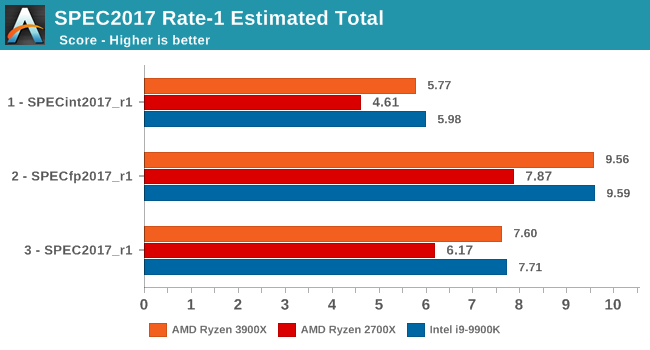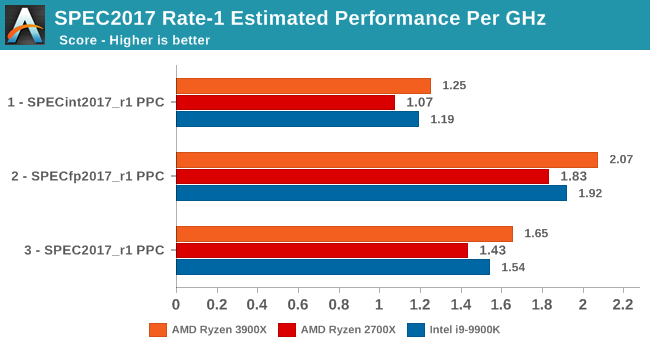The AMD 3rd Gen Ryzen Deep Dive Review: 3700X and 3900X Raising The Bar
by Andrei Frumusanu & Gavin Bonshor on July 7, 2019 9:00 AM ESTSPEC2006 & 2017: Industry Standard - ST Performance
One big talking point around the new Ryzen 3000 series is the new augmented single-threaded performance of the new Zen 2 core. In order to investigate the topic in a more controlled manner with better documented workloads, we’ve fallen back to the industry standard SPEC benchmark suite.
We’ll be investigating the previous generation SPEC CPU2006 test suite giving us some better context to past platforms, as well as introducing the new SPEC CPU2017 suite. We have to note that SPEC2006 has been deprecated in favour of 2017, and we must also mention that the scores posted today are noted as estimates as they’re not officially submitted to the SPEC organisation.
For SPEC2006, we’re still using the same setup as on our mobile suite, meaning all the C/C++ benchmarks, while for SPEC2017 I’ve also went ahead and prepared all the Fortran tests for a near complete suite for desktop systems. I say near complete as due to time constraints we’re running the suite via WSL on Windows. I’ve checked that there are no noticeable performance differences to native Linux (we’re also compiling statically), however one bug on WSL is that it has a fixed stack size so we’ll be missing 521.wrf_r from the SPECfp2017 collection.
In terms of compilers, I’ve opted to use LLVM both for C/C++ and Fortran tests. For Fortran, we’re using the Flang compiler. The rationale of using LLVM over GCC is better cross-platform comparisons to platforms that have only have LLVM support and future articles where we’ll investigate this aspect more. We’re not considering closed-sourced compilers such as MSVC or ICC.
clang version 8.0.0-svn350067-1~exp1+0~20181226174230.701~1.gbp6019f2 (trunk) clang version 7.0.1 (ssh://git@github.com/flang-compiler/flang-driver.git 24bd54da5c41af04838bbe7b68f830840d47fc03) -Ofast -fomit-frame-pointer -march=x86-64 -mtune=core-avx2 -mfma -mavx -mavx2
Our compiler flags are straightforward, with basic –Ofast and relevant ISA switches to allow for AVX2 instructions.
The Ryzen 3900X system was run in the same way as the rest of our article with DDR4-3200CL16, same as with the i9-9900K, whilst the Ryzen 2700X had DDR-2933 with similar CL16 16-16-16-38 timings.

In terms of the int2006 benchmarks, the improvements of the new Zen2 based Ryzen 3900X is quite even across the board when compared to the Zen+ based Ryzen 2700X. We do note however somewhat larger performance increases in 403.gcc and 483.xalancbmk – it’s not immediately clear as to why as the benchmarks don’t have one particular characteristic that would fit Zen2’s design improvements, however I suspect it’s linked to the larger L3 cache.
445.gobmk in particular is a branch-heavy workload, and the 35% increase in performance here would be better explained by Zen2’s new additional TAGE branch predictor which is able to reduce overall branch misses.
It’s also interesting that although Ryzen3900X posted worse memory latency results than the 2700X, it’s still able to outperform the latter in memory sensitive workloads such as 429.mcf, although the increases for 471.omnetpp is amongst the smallest in the suite.
However we still see that AMD has an overall larger disadvantage to Intel in these memory sensitive tests, as the 9900K has large advantages in 429.mcf, and posting a large lead in the very memory bandwidth intensive 462.libquantum, the two tests that put the most pressure on the caches and memory subsystem.

In the fp2006 benchmarks, we gain see some larger jumps on the part of the Ryzen 3900X, particularly in 482.sphinx3. These two tests along with 450.soplex are characterized by higher data cache misses, so Zen2’s 16MB L3 cache should definitely be part of the reason we see such larger jumps.
I found it interesting that we’re not seeing much improvements in 470.lbm even though this is a test that is data store heavy, so I would have expected Zen2’s additional store AGU to greatly benefit this workload. There must be some higher level memory limitations which is bottlenecking the test.
453.povray isn’t data heavy nor branch heavy, as it’s one of the more simple workloads in the suite. Here it’s mostly up to the execution backend throughput and the ability of the front-end to feed it fast enough that are the bottlenecks. So while the Ryzen 3900X provides a big boost over the 2700X, it’s still largely lagging behind the 9900K, a characteristic we’re also seeing in the similar execution bottlenecked 456.hmmer of the integer suite.

Overall, the 3900X is 25% faster in the integer and floating point tests of the SPEC2006 suite, which corresponds to an 17% IPC increase, above AMD's officially published figures for IPC increases.
Moving on to the 2017 suite, we have to clarify that we’re using the Rate benchmark variations. The 2017 suite’s speed and rate benchmarks differ from each other in terms of workloads. The speed tests were designed for single-threaded testing and have large memory demands of up to 11GB, while the rate tests were meant for multi-process tests. We’re using the rate variations of the benchmarks because we don’t see any large differentiation between the two variations in terms of their characterisation and thus the performance scaling between the both should be extremely similar. On top of that, the rate benchmarks take up to 5x less time (+1 hour vs +6 hours), and we're able run them on more memory limited platforms (which we plan on to do in the future).

In the int2017 suite, we’re seeing similar performance differences and improvements, although this time around there’s a few workloads that are a bit more limited in terms of their performance boosts on the new Ryzen 3900X.
Unfortunately I’m not quite as familiar with the exact characteristics of these tests as I am with the 2006 suite, so a more detailed analysis should follow in the next few months as we delve deeper into microarchitectural counters.

In the fp2017 suite, things are also quite even. Interesting enough here in particular AMD is able to leapfrog Intel’s 9900K in a lot more workloads, sometimes winning in terms of absolute performance and sometimes losing.

As for the overall performance scores, the new Ryzen 3900X improves by 23% over the 2700X. Although closing the gap greatly and completely, it’s just a hair's width shy of actually beating the 9900K’s absolute single-threaded performance.

Normalising the scores for frequency, we see that AMD has achieved something that the company hasn’t been able to claim in over 15 years: It has beat Intel in terms of overall IPC. Overall here, the IPC improvements over Zen+ are 15%, which is a bit lower than the 17% figure for SPEC2006.
We already know about Intel’s new upcoming Sunny Cove microarchitecture which should undoubtedly be able to regain the IPC crown with relative ease, but the question for Intel is if they’ll be able to still maintain the single-thread absolute performance crown and continue to see 5GHz or similar clock speeds with the new core design.










447 Comments
View All Comments
Phynaz - Sunday, July 7, 2019 - link
None of the above ever affected me. So you’ll excuse me if I’m not enraged that “lied” about 10nm. No one from Intel ever said a thing to me about 10nm so I was never lied to.Now when AMD pulled promised compatibility for Zen 2, that’s being lied to. I wonder if AMD has offered compensation to people that bought those boards/systems to people that bought them for that reason.
Although if you bought them for that reason, well you’re a moron, because this is the THIRD time AMD lied about an upgrade path.
Korguz - Monday, July 8, 2019 - link
then you obviously are only here to lie... intel has said that 10 nm was on track, 3 or 4 YEARS AGO, but yet.. 10nm is only now starting to show up... intel has been on 14nm since around 2014 i think it was.. and from their roadmaps from then, they should of switched to 10nm around 2016/2017they pulled it.. because it wasnt as viable as they originally thought.. which is good on them for that, how angry would people be if they didnt, then people upgraded to it, and didnt get what amd said ?? i dont think many bought anything for that reason.. but who knows for sure...
and how have they lied for the 3rd time about an upgrade path ??
seems the only moron here.. is you, as you keep post lies and BS.....
Phynaz - Monday, July 8, 2019 - link
Time for your AMD history lesson.Quadfather
Piledriver
And now Zen 2
AMD fans , taking it in the butt for decades.
My suggestion is get a job so you can afford a real cpu
Korguz - Monday, July 8, 2019 - link
um ya ok.. you are just as bad there phynaz.... intel fan talking out of his own butt.. you are not even a little pissed that intel stuck the mainstream at quad core ?? or charging too much ? fyi.. you need and education.. amd has been with am4 alot longer then intel has with its sockets.. and those names you list.. are the code names... not the product.. and quad father... was way back in the a64 days...what compatibility are you referring to then ???
Phynaz - Monday, July 8, 2019 - link
So you agree that AMD fucked it’s customers after getting their money. It’s good AMD hasn’t completely rotted your brain.Xylade - Monday, July 8, 2019 - link
Complete re-tarded intel fanboi. Even after reading the article your demented mind still can't catch up.Phynaz - Monday, July 8, 2019 - link
Please keep up with the times, retard isn’t acceptable language. Idiot and moron are short enough that they ought to fit in that teensy tiny cranium of yours.Korguz - Tuesday, July 9, 2019 - link
but intel sure has rotted your brain. with intel, you were lucky to be able to use the same board for more then 2 cpus. my x99 board.. only 2 generations of cpus were available for it. for amd, AM4 started with ryzen 1, then ryzen 2, and now. ryzen 3, thats 3 generations of zen.. in the case of am3+, you could use cpus for am3+, am3, and in some cases cpu's for am2 as well, all in the same socket. quadfather, was amd's attempt at giving the mainstream a dual socket platform, with out the server price take or features that went along with it. historically, amd has given a much longer upgrade path then intel ever has. how did i agree that amd screwed its customers ? for the most part, intel has screwed its customers, over and over, as i have mentioned in my previous postKorguz - Sunday, July 7, 2019 - link
waltC " For what it's worth, we rarely give out any awards at all. The award tiers are Silver, Gold, Platinum. The 9900K never even got an award, so in our view the new Ryzen chips are overall better products. " seems for AT silver is the top award... not gold.. :-)Phynaz - Sunday, July 7, 2019 - link
AMD fanboys: Catching up to intel should be the top award.Rest of world: Umm, nooooo, that’s not the way awards work.